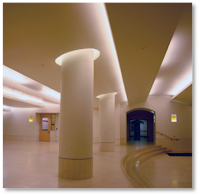The Two Cultures topic
is very relevant to my personal and academic history. I have been a dancer my entire life, and my
focus in school, beginning in the seventh grade, has been on performing
arts. My mental strengths are greater in
the arts compared to math and science.
As
a World Arts and Cultures Major, I have been secluded in Kaufman Hall, rarely
venturing into South campus where the sciences are taught. When I walk into Kaufman Hall pictured here,
I feel as if I’m not on the UCLA campus.
The astrology department building represents a clear distinction between
my artistic studies in North campus and the hard sciences in South campus. The differences are plainly seen in the architectural differences between the North and South campus sections.
 |
| Kaufman Hall http://baswaphon.com/portfolio/ucla-kaufman-hall |
 |
| Murphy Sculpture Garden http://luskinconferencecenter.ucla.edu/about/things-to-do-ucla/ |
I envy those who can
bridge the gap between art and science, combining both in order to understand each
better. Dance is an artistic
presentation involving a precise use of the body, which is analyzed
scientifically in detail in South campus.
The body connection leads many dancers into physical therapy,
physiology, kinesiology and other sciences to more fully understand the body’s
functions in dance.
While researching for
this piece, I came across a program called Dance Science at
Trinity Laban. It is a school where
students study the physical demands and effects of dance on the body. They use masks to capture breathing patterns,
studying one dancer over a period of time to acquire data based on the effects
of movement.
 |
| Dance Science http://www.trinitylaban.ac.uk/study/dance/dance-science |
Similarly, Elon
University offers a Dance Science degree, where the “focus is on the practical
applications of scientific principles to enhance dance and movement.”
Citations:
Baswa Acoustics. UCLA Kaufman Hall. Web. 3 April 2016. http://baswaphon.com/portfolio/ucla-kaufman-hall
Cathy Roe Dance. Anatomy and Kinesiology for Dancers. YouTube. 3 April 2016. https://www.youtube.com/watch?v=Ez9jNOGn_i4
Elon University. Dance Science Admissions. Web. 3 April 2016. http://www.elon.edu/e-web/admissions/majorsheets/dance_science.xhtml
Trinity Laban Conservatoire of Music and Dance. Web. 3 April 2016. http://www.trinitylaban.ac.uk/study/dance/dance-science
UCLA Division of Astronomy and Astrophysics. Planetarium and Telescope Shows. Web. 3 April 2016. http://www.astro.ucla.edu/planetarium/directions/

I enjoyed reading this blog because it presented a perspective on particular points that I haven't seen yet. The recognition of the architectural difference of North and South Campus is one I had not taken note of prior to reading this blog. I feel as though you can go into further explanation of an architectural attempt at a third culture bridge seen in the buildings deeper into South Campus. California NanoSystems Institute and the Orthopedic Hospital Research Center incorporate an artistic layout while being two of the most science-intensive buildings on campus. I feel that because South and North Campus majors are, in a way, "stuck" on their sides of campus they each do not notice the outreach to incorporate Artistic nuances in Science locations and vice versa. Furthermore, the connection between the artistic nature of dancers and the physiology required to understand the science behind the movements is a great example of how the two opposite cultures interact in discrete ways that aren't always recognized today.
ReplyDelete